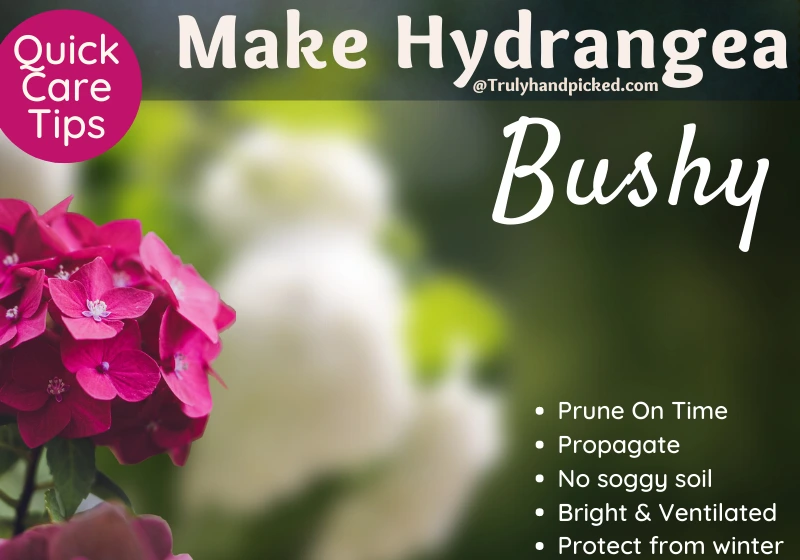Hydrangea is a flowering plant that includes almost 75 different species in its single genera. This deciduous shrub is very popular among new-age gardeners due to being spectacular ornamental plant.
Its flower bunches can grow in various vibrant shades and appear mesmerizing when blooming around varying deep green foliage. It is a drought-tolerant flowering shrub that can grow up to 10-15 ft. tall with full maturity.
Hydrangea has low maintenance and thus, is easy to cultivate in your yard. However, a few particular things you must comprehend before growing one species of hydrangea in your garden are as follows-

How To Make Hydrangea Bushy?
To keep your garden hydrangea bushy and full of foliage, you must give the new shoot enough room to thrive. Instigating the new branches and leaves are one more crucial endeavor you can take here to make your growing hydrangea desirably bushy. Here are some quick tips in this regard-
Prune On Time:
- Pruning is the most important part of making a growing hydrangea healthier and bushier
- You have to cut back the old and overcrowded branches to get the new dense stems
- The best time to prune a hydrangea is in winter and sometimes in early spring
- You can perform an annual pruning session for your growing hydrangea
- This way you can hold the bushier form of it for year long
- However, you can increase or decrease the pruning session according to the growth rate of your selected hydrangea species
- To prune a hydrangea plant perfectly, bring a sharp shear or saw
- Disinfect them with rubbing alcohol or any other effective sterilize liquid
- Now cut back dead stems and congested stems, especially, which join at the living branches
- Try to remove the tips of new growth during this pruning process
- And cut off all old and discolored leaves during the process to give the new foliage to emerge well
Related: How to Make Your Hydrangea Bloom
Pinch Out New Leaves:
- Besides cutting back the old and leggy parts, you need to pinch out the newly emerged leaves
- When the soft and green new shots get pinched out daily, the fresh stems won’t grow long
- At the same time, they encourage the formation of many side-shots
- This way you will get the bushiest form of your growing hydrangea within a couple of months
Propagate:
- Propagate your growing hydrangea is one more smart idea to encourage its growth
- To do this, you can cut off all the stems on the shrub halfway along with their length
- Simply choose the fresh and undamaged parts from your pruned collections
- Now, replant them in a new planter with a whole new set of potting mix
Choose The Best Location:
- Place or sow your hydrangea plant in a sunny location
- Make sure your plant could get full sun in the morning and some shade in the afternoon
- Some species of this flowering plant can grow in full or partial shade
- Pick those species for indoor cultivation to get the healthiest form of your plant
Related: How to make your coleus bushy
Avoid Soggy Soil and Poor Drainage:
- To let your hydrangea stem healthy, you must let them hydrate well
- Hydration doesn’t mean overwatering here or letting your plant stay in a soggy situation
- Try to give your plant a moderately moist but not soggy growing medium
- To allow that you must provide your plant an excellent drainage quality in your soil
Choose a Ventilated Spot:
- To offer your plant a big blooming beauty, try to give your plant good air circulation
- Let the air pass in the room with enough open windows or doors, where you put our planter
- You don’t need to think about the humidity level more when the air can flow well around your plant
- So, a gentle breeze is always essential to hold the healthiest form of your plant in a natural manner
Protect From Winter:
- Winter or heavy frost is an obstacle that can hold your plant back from starting the bushiest form
- So, you must be determined to protect your plant during this harsh season of the year
- Try to bring the outdoor plant inside your house and place them in a secured spot until the frost passes
- If you can’t bring the plants inside, try to cover them with a blanket or provide shade throughout the entire season
Apply these hacks, be attentive towards your growing hydrangea, and never let it be nutrient deficient or thirsty ever. You will see the difference soon and get the evergreen bushiest form of your plant for sure.
Related: How to make your wandering jew plant bushy

When and Where To Plant Hydrangeas?
When To Plant Hydrangea:
To get the best blooming form of hydrangea, you must plant it properly and at the correct time. Here are some best possible timings of when to start the plantation and repot of a hydrangea plant to get the most desirable outcome-
- You should start the first plantation during the fall or early spring and follow the rule for replantation as well
- This way you can give your newly planted hydrangea enough time to establish itself before the next winter comes
- To do the job, choose the morning or afternoon period of a day
- This phrase also gives your freshly potted plant enough time to settle before the dappled afternoon sun appears
- Avoid planting a hydrangea during winter or at night to avert the possibility of dying or falling hydrangea
- Protect your plant from heat stress and overwatering issues for the first couple of weeks
- Keep your plant well-watered and provide a moderate amount of sunlight for the first 2-3 weeks. You will end up with a successful experience of planting hydrangea for sure.
Where To Plant Hydrangea:
To find the best place for your hydrangea, keep these points in mind-
- Hydrangea loves the warm morning sun every single day
- So, place or plant your hydrangea where it can grab 6-7 hours of warm sunlight daily
- However, it doesn’t like to get scorched under the heavy afternoon sun
- Hence, try to provide some shelter to your plant during the afternoons
- It can be a great houseplant, so, you can grow it happily indoors
- This way you can protect them from heavy winds as well, which often destroy the delicate leaves and flowers of a growing hydrangea plant.
When And How Often To Feed Hydrangea?
Hydrangea plants are quite particular about their fertilization. Dissimilar species of hydrangea need different types of fertilization. You have to pick the right fertilizer for your chosen species. Here are some useful tips in this regard-
- Hydrangea with smooth foliage needs one fertilization session per year
- Big-foliage hydrangea variety needs several light-fertilization courses throughout the year
- Some specific varieties like oakleaf, panicle, etc. need two to three times fertilization per year
- In general, you can feed a growing hydrangea plant with any balanced commercial fertilizer once or twice a year
When To Feed Your Hydrangea:
Most hydrangea species should be fed during the summer and early rainy seasons for the best outcome. Try to do it during March, May, and July every year. For plants that need more than once or twice fertilization, you can feed them during late spring and early summer as well.
How to Feed Your Hydrangea:
To feed hydrangea plants, prepare a well-balanced fertilizer with about a 10-10-10 NPK ratio and ensure it has slow-release quality. Lightly cover the soil with a single sprinkle of this fertilizer. Don’t forget the water the soil before fertilization. A moist soil surface can grab the nutrients and spread them through the roots more quickly.